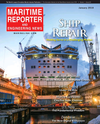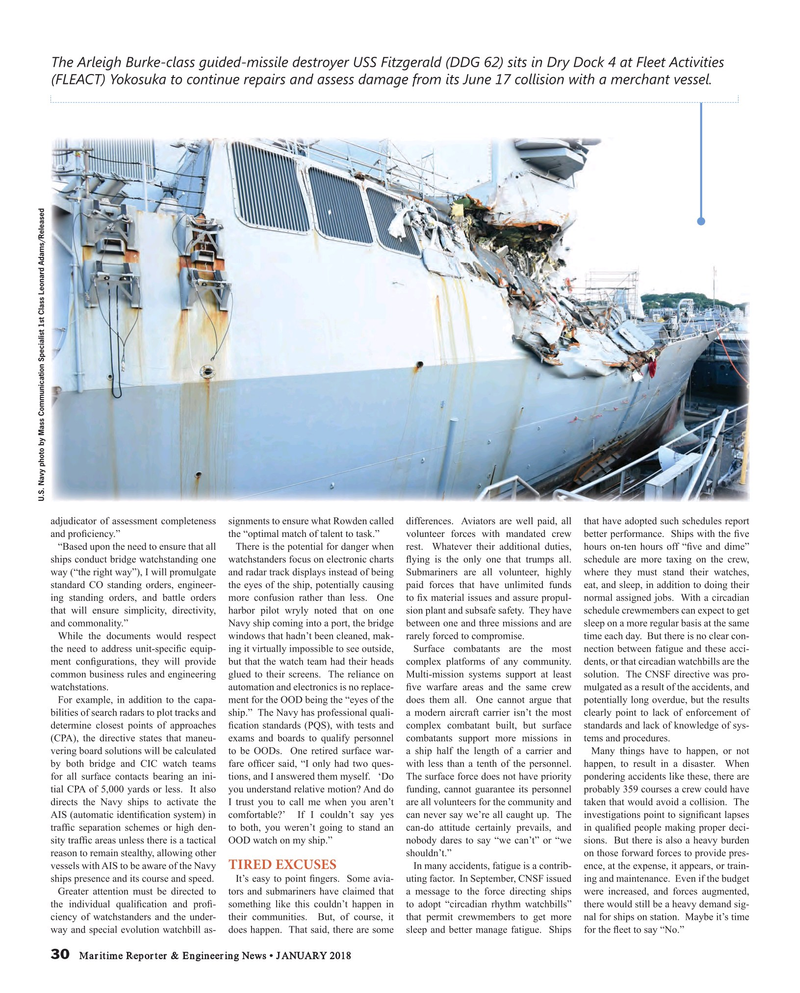
Page 30: of Maritime Reporter Magazine (January 2018)
Ship Repair & Conversion
Read this page in Pdf, Flash or Html5 edition of January 2018 Maritime Reporter Magazine
The Arleigh Burke-class guided-missile destroyer USS Fitzgerald (DDG 62) sits in Dry Dock 4 at Fleet Activities (FLEACT) Yokosuka to continue repairs and assess damage from its June 17 collision with a merchant vessel.
U.S. Navy photo by Mass Communication Specialist 1st Class Leonard Adams/Released adjudicator of assessment completeness signments to ensure what Rowden called differences. Aviators are well paid, all that have adopted such schedules report and pro? ciency.” the “optimal match of talent to task.” volunteer forces with mandated crew better performance. Ships with the ? ve “Based upon the need to ensure that all There is the potential for danger when rest. Whatever their additional duties, hours on-ten hours off “? ve and dime” ships conduct bridge watchstanding one watchstanders focus on electronic charts ? ying is the only one that trumps all. schedule are more taxing on the crew, way (“the right way”), I will promulgate and radar track displays instead of being Submariners are all volunteer, highly where they must stand their watches, standard CO standing orders, engineer- the eyes of the ship, potentially causing paid forces that have unlimited funds eat, and sleep, in addition to doing their ing standing orders, and battle orders more confusion rather than less. One to ? x material issues and assure propul- normal assigned jobs. With a circadian that will ensure simplicity, directivity, harbor pilot wryly noted that on one sion plant and subsafe safety. They have schedule crewmembers can expect to get and commonality.” Navy ship coming into a port, the bridge between one and three missions and are sleep on a more regular basis at the same
While the documents would respect windows that hadn’t been cleaned, mak- rarely forced to compromise. time each day. But there is no clear con- the need to address unit-speci? c equip- ing it virtually impossible to see outside, Surface combatants are the most nection between fatigue and these acci- ment con? gurations, they will provide but that the watch team had their heads complex platforms of any community. dents, or that circadian watchbills are the common business rules and engineering glued to their screens. The reliance on Multi-mission systems support at least solution. The CNSF directive was pro- watchstations. automation and electronics is no replace- ? ve warfare areas and the same crew mulgated as a result of the accidents, and
For example, in addition to the capa- ment for the OOD being the “eyes of the does them all. One cannot argue that potentially long overdue, but the results bilities of search radars to plot tracks and ship.” The Navy has professional quali- a modern aircraft carrier isn’t the most clearly point to lack of enforcement of determine closest points of approaches ? cation standards (PQS), with tests and complex combatant built, but surface standards and lack of knowledge of sys- (CPA), the directive states that maneu- exams and boards to qualify personnel combatants support more missions in tems and procedures. vering board solutions will be calculated to be OODs. One retired surface war- a ship half the length of a carrier and Many things have to happen, or not by both bridge and CIC watch teams fare of? cer said, “I only had two ques- with less than a tenth of the personnel. happen, to result in a disaster. When for all surface contacts bearing an ini- tions, and I answered them myself. ‘Do The surface force does not have priority pondering accidents like these, there are tial CPA of 5,000 yards or less. It also you understand relative motion? And do funding, cannot guarantee its personnel probably 359 courses a crew could have directs the Navy ships to activate the I trust you to call me when you aren’t are all volunteers for the community and taken that would avoid a collision. The
AIS (automatic identi? cation system) in comfortable?’ If I couldn’t say yes can never say we’re all caught up. The investigations point to signi? cant lapses traf? c separation schemes or high den- to both, you weren’t going to stand an can-do attitude certainly prevails, and in quali? ed people making proper deci- sity traf? c areas unless there is a tactical OOD watch on my ship.” nobody dares to say “we can’t” or “we sions. But there is also a heavy burden reason to remain stealthy, allowing other shouldn’t.” on those forward forces to provide pres-
TIRED EXCUSES vessels with AIS to be aware of the Navy In many accidents, fatigue is a contrib- ence, at the expense, it appears, or train- ships presence and its course and speed. It’s easy to point ? ngers. Some avia- uting factor. In September, CNSF issued ing and maintenance. Even if the budget
Greater attention must be directed to tors and submariners have claimed that a message to the force directing ships were increased, and forces augmented, the individual quali? cation and pro? - something like this couldn’t happen in to adopt “circadian rhythm watchbills” there would still be a heavy demand sig- ciency of watchstanders and the under- their communities. But, of course, it that permit crewmembers to get more nal for ships on station. Maybe it’s time way and special evolution watchbill as- does happen. That said, there are some sleep and better manage fatigue. Ships for the ? eet to say “No.” 30 Maritime Reporter & Engineering News • JANUARY 2018
MR #1 (26-33).indd 30 MR #1 (26-33).indd 30 1/17/2018 4:44:31 PM1/17/2018 4:44:31 PM

 29
29

 31
31
